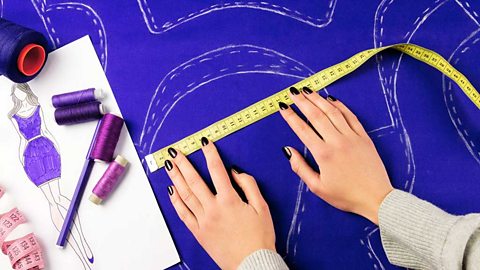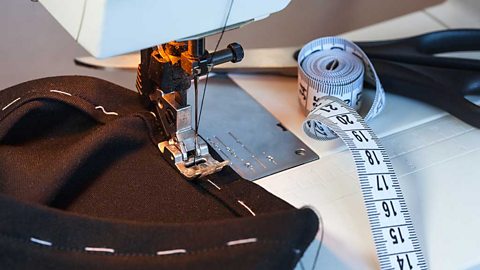Producing garments
Using a pattern
Fashion designers need to turn their 2D illustration into a 3D garment. They use paper patterns and templates to create their garment.
Designers draw paper patterns onto Spot and cross paperA type of paper with dots and crosses which allows the user to make diagrams such as 3d representations more easily than with other types of paper. In industry, pattern blocks are made from card so that they can withstand regular use
Commercial patterns are made out of tissue paper with the pattern digitally printed onto it for the dressmaker to cut out.
These are laid onto fabric, pinned or weighted in place and used as templates to cut out the fabric panels which are sewn together to create a garment.

Sample making
Before making their final garment, designers produce a practice version out of cheaper fabric, usually calico. This is called a toileAn early model of a textiles product.. Designers will use this to see how the product looks when it is made from fabric. While it is being worn by a mannequinA body-shaped model. or model, designers and dressmakers can make any adjustments to the size and shape of the garment.
Sewing and assembly

Garments are usually produced using a sewing machine.
When using a sewing machine it is important to use the correct presser foot, needle and thread for the type of fabric that is being sewn.
The fabric panels are pinned or tacked together and sewn along the seamA seam is usually 1.5 cm wide and is produced by sewing two pieces of fabric together. . The type of seam used depends on the types of fabric and how it needs to look.
hemWhere the edge of cloth is folded and sewn to protect it are used to neaten the edge of the fabric. These can be either hand or machine sewn.
There are a variety of techniques which can be used to make garments. These include: darts, gathers, pleats and smocking.
Fastenings can be used to improve the functionality of a garment. Types of fastenings include buttons, hooks and loops, and zips.
Pressing and finishing
It is important to iron seams flat so that the fabric hangs correctly. There are different shaped ironing boards and padded forms to press the fabric against so that it stays in shape. For more delicate fabrics designers will use steam to remove creases.
Finishing touches in the form of decorations can be added to garments during or after construction.
Fabric panels can be decorated with hand or machine embroidery before being sewn together.
Buttons, beads, sequins and other embellishments can be sewn on the outer layers of a garment before the lining is sewn in place.